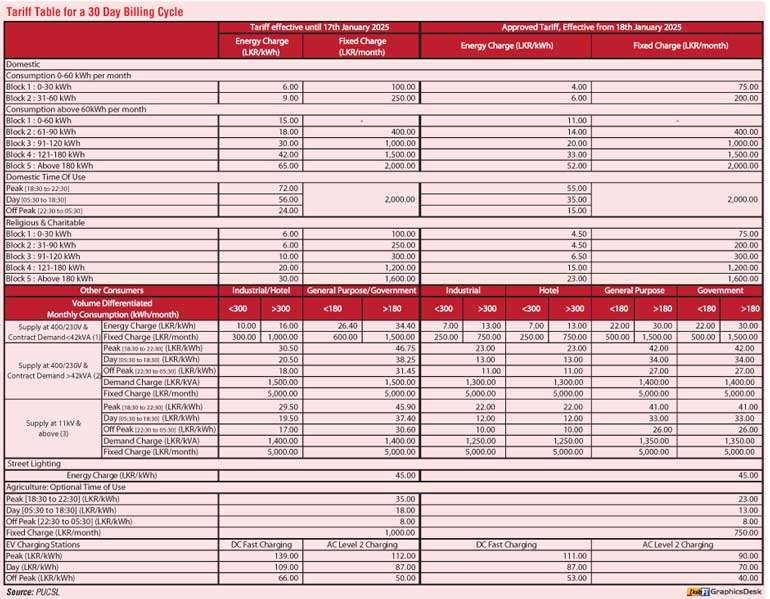PUCSL approves 20% electricity tariff cut across the board
Saturday, 18 January 2025 01:11 – – 15

PUCSL Director Communications Jayanath Herath
- Move will see average reduction for all categories from today
- Domestic users see 20% average decrease, with low-usage households benefitting most with over 25%
- Hotels and industries get largest billing relief at 31% and 30%, respectively
- Public sector rates reduced by 12%, street lamps and State institutions receiving 11% cut
- Electricity regulator identifies surplus of Rs. 44.07 b, enabling tariff reductions despite CEB’s initial forecast of mere Rs. 2.34 b
- New framework incentivises renewable energy, increasing contributions from hydroelectric, non-conventional renewable energy sources
- Incorporates claw-back mechanism addressing inefficiencies, recovering underutilised amounts from past OPEX and CAPEX
- PUCSL Director Communications Jayanath Herath says CEB is obliged to comply with recommendations under Sri Lanka Public Utilities Commission Act
- Imposes several conditions for CEB including fuel supply agreement by March 2025, user consent for e-billing, adjusting fixed charges for prosumers based on net usage
By Charumini de Silva
In a long-awaited move, the Public Utilities Commission of Sri Lanka (PUCSL) yesterday announced an average 20% reduction in electricity tariffs for all categories for the first six months of the year, effective from today (18).
The decision follows the third delayed tariff revision of 2024 and was finalised after extensive public consultations and a detailed review of proposals from the Ceylon Electricity Board (CEB), reflecting adjustments in operational efficiencies and surplus revenues among other factors.
Addressing the media, PUCSL Director Communications Jayanath Herath said the revision was based on a cost-reflective tariff methodology and explained that the structure balances affordability for electricity users, whilst enabling the CEB to break-even and progress towards financial stability.
The latest tariff revision for the next six months has slashed electricity rates for domestic users by an average of 20%, while rates for places of worship and charitable institutions see a 21% reduction.
Hotel and industrial operations were extended the largest decreases, at 31% and 30%, respectively.
Public sector rates were trimmed by 12%, with State institutions and street lamps receiving a 11% cut.
Originally, the CEB proposed maintaining the existing tariffs for the first half of 2025. However, after reviewing the utility’s projections, the electricity regulator – PUCSL – published a counter proposal in December 2024, which ultimately formed the basis for the new rates.
Previously, under the former administration, electricity tariff was subject to quarterly revisions, but in 2023 the tariff structure was revised only three times, while two revisions were implemented in 2024.
The tariff revision marks the first revision since July 2024 and is viewed as a critical step towards easing financial pressure on households and businesses facing the highest electricity tariffs in the region.
Herath said domestic electricity users will experience the largest reductions, with low-usage households benefitting from decreases exceeding 25%, addressing equity concerns and promoting affordability for vulnerable groups.
He added that industrial users will also see tangible benefits for energy-intensive sectors, such as hospitality and manufacturing, which will eventually translate positively into their competitiveness.
The adjustments come after a series of nine public consultations held across all provinces from 27 December 2024 to 10 January 2025, during which stakeholders urged electricity tariff reductions between 20% to 30%. Over 400 submissions were made during these sessions, highlighting concerns over the affordability of electricity amid the soaring cost of living following the economic crisis.
As per the full report of the PUCSL for tariff revision, the CEB’s initial submission projected a surplus of Rs. 2.34 billion (Rs. 2,334 million) for the first half of 2025, suggesting no need for a tariff reduction. Nevertheless, the PUCSL, after identifying further cost rationalisation opportunities in generation and operational expenditures, revised the forecasted surplus to Rs. 44.07 billion (Rs. 44,075 million), enabling more room for a substantial average tariff reduction of 20.08%.
The revision also incorporates a claw-back mechanism that addressed inefficiencies, recovering underutilised amounts from past operational (OPEX) and capital expenses (CAPEX).
According to the report, the new tariff framework is the incentivisation of renewable energy. The PUCSL has adjusted generation forecasts to prioritise non-conventional renewable energy (NCRE) sources, reflecting the country’s commitment to reducing dependence on costly and environmentally harmful oil-based power generation. More hydroelectric and NCRE contributions have been revised upward based on more realistic assessments, aligning generation plans with sustainable energy objectives.
When asked if the CEB would adhere to the new tariff reductions, Herath said the utility is obliged to comply with the PUCSL’s recommendations under the Sri Lanka Public Utilities Commission Act.
He also said the Commission has imposed several conditions for the CEB to enhance operational efficiency and accountability. These include finalising a fuel supply agreement by 31 March 2025, ensuring written consent from electricity users before transitioning to SMS or e-billing, and adjusting fixed charges for prosumers based on net usage.






